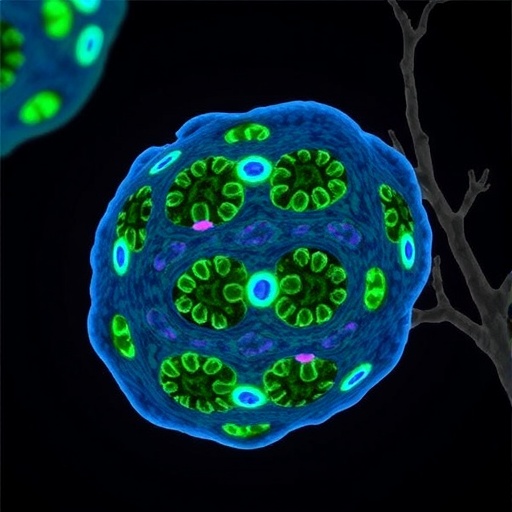In the intricate landscape of cellular biology, maintaining mitochondrial integrity is paramount for cell survival and function. Mitochondria, often termed the powerhouses of the cell, are essential organelles responsible for producing adenosine triphosphate (ATP), the cell’s primary energy currency. However, under conditions of cellular stress, these mitochondria can sustain damage, jeopardizing cellular homeostasis and potentially triggering a cascade of deleterious events. Recent groundbreaking research spearheaded by Ali, Anjali, and Mapa has shed new light on a critical molecular player—ANKZF1—that facilitates the removal of stress-damaged mitochondria through a specialized autophagic process mediated by the LC3 protein, enriching our understanding of mitophagy and its implications in cellular health.
Mitophagy is a selective autophagic mechanism that targets defective or superfluous mitochondria for degradation, thus safeguarding cellular homeostasis by curtailing the buildup of malfunctioning organelles that could otherwise instigate oxidative stress or apoptosis. Until now, the molecular intricacies governing the recognition and elimination of these compromised mitochondria have been incompletely understood. The discovery of ANKZF1’s role in this finely tuned quality control system signifies a pivotal advancement in the field, unveiling novel aspects of how cells identify and selectively dispose of damaged mitochondrial components.
At the heart of this process lies the interplay between ANKZF1 and LC3, the microtubule-associated protein light chain 3 renowned for its central role in autophagosome formation. Autophagy, a vital catabolic mechanism, involves the sequestration of damaged organelles or proteins within double-membraned vesicles called autophagosomes, which subsequently fuse with lysosomes for degradation. The study demonstrates that ANKZF1 acts as a molecular liaison that recognizes stress-induced mitochondrial damage and facilitates the recruitment of LC3, effectively tagging these compromised mitochondria for targeted autophagic clearance.
.adsslot_2MD5ZcF8t9{ width:728px !important; height:90px !important; }
@media (max-width:1199px) { .adsslot_2MD5ZcF8t9{ width:468px !important; height:60px !important; } }
@media (max-width:767px) { .adsslot_2MD5ZcF8t9{ width:320px !important; height:50px !important; } }
ADVERTISEMENT
Mechanistically, ANKZF1 contains specific domains that enable it to spatially associate with dysfunctional mitochondria. This selective localization is triggered under cellular stress conditions, such as oxidative damage or mitochondrial membrane depolarization, hallmarks of mitochondrial distress. Through intricate protein-protein interactions, ANKZF1 recruits LC3 to the outer mitochondrial membrane, promoting the formation of mitophagosomes. These specialized autophagic vesicles encapsulate the damaged mitochondria, thereby initiating their subsequent lysosomal degradation. This revelation not only clarifies a previously obscure step in mitophagy but also highlights ANKZF1 as a critical sensor and adaptor within the mitochondrial quality control machinery.
The implications of this discovery extend well beyond basic cell biology. Mitochondrial dysfunction underlies a myriad of pathological states, including neurodegenerative diseases like Parkinson’s and Alzheimer’s, metabolic syndromes, and even oncogenesis. By delineating how ANKZF1 facilitates the autophagic removal of damaged mitochondria, the researchers have opened a promising avenue for therapeutic intervention aimed at enhancing mitophagy in diseases marked by mitochondrial impairment. Targeting ANKZF1 or its regulatory pathways could potentiate cellular resilience against mitochondrial stress, fostering novel strategies for disease modification.
Intriguingly, the study also assessed the consequences of ANKZF1 deficiency using gene knockdown models. Cells lacking sufficient ANKZF1 exhibited pronounced mitochondrial accumulation of damage markers and a significant reduction in mitophagic flux. This accumulation culminated in heightened reactive oxygen species (ROS) production and compromised mitochondrial membrane potential, underscoring the protein’s indispensable function in maintaining mitochondrial quality. Such data position ANKZF1 as a gatekeeper against mitochondrial-induced cellular demise.
Complementing these functional insights, structural analyses revealed that specific amino acid residues within ANKZF1’s ankyrin repeat and zinc finger motifs are critical for its interaction with LC3 and damaged mitochondria. Mutation of these residues abrogates mitophagic activity, highlighting the exquisite molecular specificity underpinning ANKZF1’s role. These findings fuel the prospect of designing small molecules or peptides that may modulate ANKZF1 activity, either to amplify mitophagy in disease states or to fine-tune mitochondrial dynamics in health.
The research also provocatively touches upon how ANKZF1-mediated mitophagy interfaces with cellular metabolic adaptation. Mitochondrial turnover is intimately tied to cellular energy balance and biosynthetic capacity. By ensuring the timely removal of impaired mitochondria, ANKZF1 supports the preservation of efficient respiratory function and mitigates metabolic stress. This capacity to integrate quality control with metabolic homeostasis reinforces the protein’s centrality in cellular physiology.
Notably, the study’s use of advanced imaging modalities such as super-resolution microscopy and mitochondrial-specific fluorescent probes allowed unprecedented visualization of the mitophagic process orchestrated by ANKZF1. These methodologies uncovered the dynamic recruitment patterns of LC3 to damaged mitochondria and the subsequent autophagic engulfment events, capturing the process at nanoscale resolution. Such technological marriage of molecular biology and cutting-edge imaging enriches our comprehension of autophagy’s spatial and temporal choreography.
While much remains to be explored, including the upstream signaling pathways that regulate ANKZF1 activation, this seminal work sets a foundation to investigate how cellular stress signals are integrated into mitophagic responses. Understanding these regulatory cascades could unlock new therapeutic targets and biomarkers for diseases characterized by mitochondrial stress and autophagic dysfunction.
Altogether, the discovery of ANKZF1 as a pivotal mediator of LC3-dependent mitophagy marks a significant milestone in the field of cellular homeostasis and mitochondrial biology. The study not only clarifies fundamental mechanisms of mitochondrial quality control but also paves the way for innovative interventions aimed at mitigating mitochondrial damage in human disease. As research progresses, the translational potential of manipulating ANKZF1 activity promises to reshape our approach to treating mitochondrial pathologies and enhancing cellular resilience.
In summary, the work by Ali, Anjali, and Mapa represents a profound leap forward in understanding autophagic clearance of distressed mitochondria. By identifying ANKZF1 as a molecular linchpin connecting mitochondrial stress detection to LC3-mediated mitophagy, it opens exciting prospects for both fundamental biology and clinical therapeutics. This elegant demonstration of quality control within the cell’s powerhouse underscores the intricate balance cells maintain to survive and thrive under stressful conditions, rendering ANKZF1 an alluring target for future biomedical endeavors.
Subject of Research: Molecular mechanisms of mitophagy focusing on the role of ANKZF1 in stress-damaged mitochondrial clearance.
Article Title: ANKZF1 helps to eliminate stress-damaged mitochondria by LC3-mediated mitophagy.
Article References:
Ali, M., Anjali & Mapa, K. ANKZF1 helps to eliminate stress-damaged mitochondria by LC3-mediated mitophagy. Cell Death Discov. 11, 349 (2025). https://doi.org/10.1038/s41420-025-02638-y
Image Credits: AI Generated
DOI: https://doi.org/10.1038/s41420-025-02638-y
Tags: ANKZF1 role in mitophagycellular homeostasis and functiondamaged mitochondria degradationimplications of mitophagy in diseaseLC3-mediated autophagic clearancemitochondrial integrity in cellular healthmitochondrial quality control systemsmolecular mechanisms of mitophagyoxidative stress and apoptosis preventionrecent research in cellular biologyselective autophagy mechanismsstress-induced mitochondrial damage






